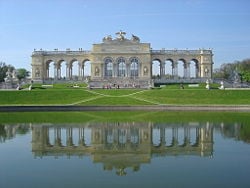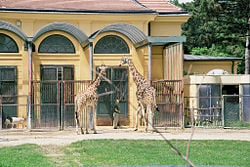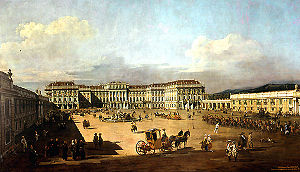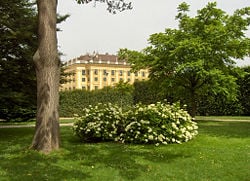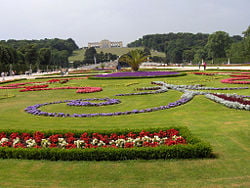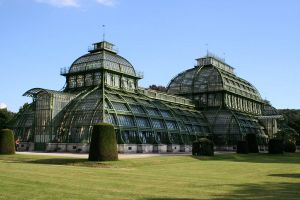Difference between revisions of "Schonbrunn Palace" - New World Encyclopedia
m (→Gallery) |
m (→External links) |
||
| Line 17: | Line 17: | ||
Schönbrunn was built to be on a par with the [[Palace of Versailles]] in terms of Baroque beauty as well as cultural and political significance, but the House of Habsburg did not have the resources to outdo its French rival. In earlier times, Schönbrunn served as summer place of residence for the various Habsburg rulers, who used it as a base to exert their power across Europe. Emperor [[Franz Joseph]] (ruled: 1848-1916), was born there in 1830 and spent the last years of his life exclusively in Schönbrunn. In 1918, the palace became the property of the new Austrian republic. | Schönbrunn was built to be on a par with the [[Palace of Versailles]] in terms of Baroque beauty as well as cultural and political significance, but the House of Habsburg did not have the resources to outdo its French rival. In earlier times, Schönbrunn served as summer place of residence for the various Habsburg rulers, who used it as a base to exert their power across Europe. Emperor [[Franz Joseph]] (ruled: 1848-1916), was born there in 1830 and spent the last years of his life exclusively in Schönbrunn. In 1918, the palace became the property of the new Austrian republic. | ||
| − | |||
| − | |||
| − | |||
| − | |||
The palace alone draws some 1.5 million visitors annually. The park and all the other attractions at Schönbrunn together attract an additional 5.2 million visitors each year, with a grand total of 6.7 million visitors to the imposing palace complex each year. | The palace alone draws some 1.5 million visitors annually. The park and all the other attractions at Schönbrunn together attract an additional 5.2 million visitors each year, with a grand total of 6.7 million visitors to the imposing palace complex each year. | ||
==Early history== | ==Early history== | ||
| − | [[Image:Schloss Schoenbrunn Gloriette DSC02028.JPG|thumb|250px|The | + | [[Image:Schloss Schoenbrunn Gloriette DSC02028.JPG|thumb|250px|The Gloriette, located behind the palace|left]] |
| − | In the year 1569, Holy Roman Emperor [[Maximilian II, Holy Roman Emperor|Maximilian II]] purchased the Katterburg, located on a large area between Meidling and Hietzing, where today Schönbrunn's parks and various buildings are situated. He showed interest in the newly founded [[zoo]], | + | [[Image:Giraffa camelopardalis Schoenbrunn01.jpg|thumb|250px|The giraffe house at the current Tiergarten Schönbrunn.]] |
| + | In the year 1569, Holy Roman Emperor [[Maximilian II, Holy Roman Emperor|Maximilian II]] purchased the Katterburg, located on a large area between Meidling and Hietzing, where today Schönbrunn's parks and various buildings are situated. He showed interest in the newly founded [[zoo]], known as the ''Tiergarten Schönbrunn'', and tried to establish not only a systematic maintenance of wild animals, but also a [[plantation]] of rare and exotic plants. Maximilian II is justifiably called the creator of Schönbrunn's garden arrangement. | ||
The new name, ''Schönbrunn'' ("beautiful well"), has its roots in a well from which water was consumed by the royal court in [[Vienna]]. During the next century many members of the royal family of Austria spent their summer vacations and hunting excursions in the Katterburg. In the days of the Turkish sieges the Katterburg was nearly destroyed and it appeared to be impossible to restore the castle. | The new name, ''Schönbrunn'' ("beautiful well"), has its roots in a well from which water was consumed by the royal court in [[Vienna]]. During the next century many members of the royal family of Austria spent their summer vacations and hunting excursions in the Katterburg. In the days of the Turkish sieges the Katterburg was nearly destroyed and it appeared to be impossible to restore the castle. | ||
== Modern palace == | == Modern palace == | ||
| − | [[Image: | + | [[Image:Canaletto (I) 059.jpg|thumb|right|300px|Schönbrunn from the front side, by Canaletto, 1758]] |
| + | [[Leopold I, Holy Roman Emperor|Emperor Leopold I]] gave architect [[Johann Bernhard Fischer von Erlach]] the order to design a new palace. His first draft was a very utopian one, dealing with different antique and contemporary ideals. His second draft showed a smaller and more realistic building. Construction began 1696, and after three years the first festivities were held in the newly built, middle part of the palace. | ||
| + | |||
| + | Not many parts of the first palace survived the next century because every emperor added or altered a bit on the inner and outer parts of the building. By order of Empress [[Maria Theresa of Austria]], the architect [[Nicolò Pacassi]] reshaped Schönbrunn Palace in the style of the [[Rococo]] era. [[Image:Wien.Schönbrunn10.jpg|thumb|250px|left|The palace, as seen from the gardens]] At the end of the so-called Theresianian epoch, Schönbrunn Palace was a vigorous center of Austria's empire and the imperial family. | ||
| − | |||
| − | |||
In the [[ninetenth century]] one name is closely connected with Schönbrunn's, Emperor [[Franz Josef I of Austria]]. He spent the majority of his life here, and died on November 21, 1916 in his sleeping room. Through the course of his reign, Schönbrunn Palace was seen as a ''Gesamtkunstwerk'' (total work of art) and remodelled in accordance with its history. | In the [[ninetenth century]] one name is closely connected with Schönbrunn's, Emperor [[Franz Josef I of Austria]]. He spent the majority of his life here, and died on November 21, 1916 in his sleeping room. Through the course of his reign, Schönbrunn Palace was seen as a ''Gesamtkunstwerk'' (total work of art) and remodelled in accordance with its history. | ||
| Line 41: | Line 39: | ||
==Recent history== | ==Recent history== | ||
| − | After the downfall of the monarchy in 1918, the newly founded Austrian Republic became the owner of Schönbrunn Palace and preserved the beautiful rooms and chambers as a museum for the visitors. In the | + | [[Image:Wien.Schönbrunn26.jpg|thumb|250px|The gardens and gloriette]] |
| + | After the downfall of the monarchy in 1918, the newly founded Austrian Republic became the owner of Schönbrunn Palace and preserved the beautiful rooms and chambers as a museum for the visitors. In the twentieth century, the palace was used several times for important events such as the historical meeting between [[John F. Kennedy]] and [[Nikita Khrushchev]] in the year 1961. [[UNESCO]] placed Schönbrunn Palace on the World Cultural Heritage List in 1996. | ||
A public [[maze]] is located in the wide gardens of Schönbrunn Palace. A fee allows entrance to the maze, as well as to a set of other outdoor puzzles, including a math game and a series of fountains. | A public [[maze]] is located in the wide gardens of Schönbrunn Palace. A fee allows entrance to the maze, as well as to a set of other outdoor puzzles, including a math game and a series of fountains. | ||
| + | [[Image:Schloss Schönbrunn Palmenhaus.jpg|thumb|left|The palm house features exotic plants displayed in three separate climate zone.]] | ||
| + | There are public tours of the palace residence itself, providing the opportunity to see the exquisite apartments of Maria Theresia, her sitting rooms, bedroom, and the parlor in which the six-year-old [[Mozart]] used to play for the Empress. Also can be seen the parlors and apartments of Imperial couple Franz Joseph and his queen, Sissi. Many of Schonbrunn's 1441 room are festooned with frescoed ceilings, crystal chandeliers, huge mirrors, and gilded ornaments. | ||
| − | + | The palace grounds are equally magnificent, with a Tirolian garden complete with original hut, orchard, and pasture farm. There is also a palm house with three climate zones, including plants brought in from rain forests from all the continents. | |
| − | |||
| − | |||
| − | |||
The sculptures in the Schönbrunn garden were generally made between 1773 and 1780 under the | The sculptures in the Schönbrunn garden were generally made between 1773 and 1780 under the | ||
the direction of [[William Beyer]]. During the execution, many sculptors were employed, among them Johann Baptist Hagenauer. | the direction of [[William Beyer]]. During the execution, many sculptors were employed, among them Johann Baptist Hagenauer. | ||
| − | |||
| − | |||
| − | |||
| − | |||
{|class="wikitable" | {|class="wikitable" | ||
|+ '''Sculptures in the Schönbrunn Garden''' | |+ '''Sculptures in the Schönbrunn Garden''' | ||
| Line 66: | Line 60: | ||
| [[Image:N06Angerona.jpg|150px]] | | [[Image:N06Angerona.jpg|150px]] | ||
|- | |- | ||
| − | |'''1''' | + | |'''1''' Artemisia II of Caria, wife of [[Mausolus]] |
| − | |'''2''' [[Calliope]], | + | |'''2''' [[Calliope]], the muse of [[poetry]] |
| − | |'''3''' [[Lucius Junius Brutus|Brutus]] | + | |'''3''' [[Lucius Junius Brutus|Brutus]] and [[Lucretia]] |
| − | |'''4''' [[Ceres (mythology)|Ceres]] the goddess of the agriculture | + | |'''4''' [[Ceres (mythology)|Ceres]] the goddess of the agriculture |
| − | |'''5''' [[Aeneas]] | + | |'''5''' [[Aeneas]] escapes from [[Troy]] |
|'''6''' [[Angerona]] | |'''6''' [[Angerona]] | ||
|- | |- | ||
| Line 80: | Line 74: | ||
|[[Image:N12Apollo.jpg|150px]] | |[[Image:N12Apollo.jpg|150px]] | ||
|- | |- | ||
| − | |'''7''' [[Jason]], | + | |'''7''' [[Jason]], the Argonaut. |
| − | |'''8''' [[Aspasia]], | + | |'''8''' [[Aspasia]], second wife of [[Pericles]] |
|'''9''' [[Omphale]] | |'''9''' [[Omphale]] | ||
| − | |'''10''' [[Flora (mythology)|Flora | + | |'''10''' The nymph [[Flora (mythology)|Flora]] |
|'''11''' [[Maenad|Bacchante]] | |'''11''' [[Maenad|Bacchante]] | ||
|'''12''' [[Apollo]] | |'''12''' [[Apollo]] | ||
| Line 107: | Line 101: | ||
==External links== | ==External links== | ||
| − | |||
*[http://www.schoenbrunn.at Official website] | *[http://www.schoenbrunn.at Official website] | ||
*[http://www.photogalerie.at/serie-1.html photograph-gallery: Schönbrunn Palace] | *[http://www.photogalerie.at/serie-1.html photograph-gallery: Schönbrunn Palace] | ||
Revision as of 17:30, 4 July 2007
| Palace and Gardens of Schönbrunn* | |
|---|---|
| UNESCO World Heritage Site | |
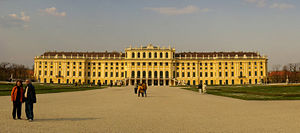
| |
| State Party | |
| Type | Cultural |
| Criteria | i, iv |
| Reference | 786 |
| Region** | Europe and North America |
| Inscription history | |
| Inscription | 1996 (20th Session) |
| * Name as inscribed on World Heritage List. ** Region as classified by UNESCO. | |
Schönbrunn Palace in Vienna is one of the most important cultural monuments in Austria and onw of Europes most popular tourist attractions. UNESCO catalogued it as a World Heritage Site, as a remarkable Baroque example of synthesis of the arts. The palace and gardens illustrate the tastes, interests, and aspirations of successive Habsburg monarchs.
Schönbrunn was built to be on a par with the Palace of Versailles in terms of Baroque beauty as well as cultural and political significance, but the House of Habsburg did not have the resources to outdo its French rival. In earlier times, Schönbrunn served as summer place of residence for the various Habsburg rulers, who used it as a base to exert their power across Europe. Emperor Franz Joseph (ruled: 1848-1916), was born there in 1830 and spent the last years of his life exclusively in Schönbrunn. In 1918, the palace became the property of the new Austrian republic.
The palace alone draws some 1.5 million visitors annually. The park and all the other attractions at Schönbrunn together attract an additional 5.2 million visitors each year, with a grand total of 6.7 million visitors to the imposing palace complex each year.
Early history
In the year 1569, Holy Roman Emperor Maximilian II purchased the Katterburg, located on a large area between Meidling and Hietzing, where today Schönbrunn's parks and various buildings are situated. He showed interest in the newly founded zoo, known as the Tiergarten Schönbrunn, and tried to establish not only a systematic maintenance of wild animals, but also a plantation of rare and exotic plants. Maximilian II is justifiably called the creator of Schönbrunn's garden arrangement.
The new name, Schönbrunn ("beautiful well"), has its roots in a well from which water was consumed by the royal court in Vienna. During the next century many members of the royal family of Austria spent their summer vacations and hunting excursions in the Katterburg. In the days of the Turkish sieges the Katterburg was nearly destroyed and it appeared to be impossible to restore the castle.
Modern palace
Emperor Leopold I gave architect Johann Bernhard Fischer von Erlach the order to design a new palace. His first draft was a very utopian one, dealing with different antique and contemporary ideals. His second draft showed a smaller and more realistic building. Construction began 1696, and after three years the first festivities were held in the newly built, middle part of the palace.
Not many parts of the first palace survived the next century because every emperor added or altered a bit on the inner and outer parts of the building. By order of Empress Maria Theresa of Austria, the architect Nicolò Pacassi reshaped Schönbrunn Palace in the style of the Rococo era.
At the end of the so-called Theresianian epoch, Schönbrunn Palace was a vigorous center of Austria's empire and the imperial family.
In the ninetenth century one name is closely connected with Schönbrunn's, Emperor Franz Josef I of Austria. He spent the majority of his life here, and died on November 21, 1916 in his sleeping room. Through the course of his reign, Schönbrunn Palace was seen as a Gesamtkunstwerk (total work of art) and remodelled in accordance with its history.
The palace complex includes sets of faux Roman ruins and an orangerie, a botanical garden, staple luxuries of European palaces of its type.
Recent history
After the downfall of the monarchy in 1918, the newly founded Austrian Republic became the owner of Schönbrunn Palace and preserved the beautiful rooms and chambers as a museum for the visitors. In the twentieth century, the palace was used several times for important events such as the historical meeting between John F. Kennedy and Nikita Khrushchev in the year 1961. UNESCO placed Schönbrunn Palace on the World Cultural Heritage List in 1996.
A public maze is located in the wide gardens of Schönbrunn Palace. A fee allows entrance to the maze, as well as to a set of other outdoor puzzles, including a math game and a series of fountains.
There are public tours of the palace residence itself, providing the opportunity to see the exquisite apartments of Maria Theresia, her sitting rooms, bedroom, and the parlor in which the six-year-old Mozart used to play for the Empress. Also can be seen the parlors and apartments of Imperial couple Franz Joseph and his queen, Sissi. Many of Schonbrunn's 1441 room are festooned with frescoed ceilings, crystal chandeliers, huge mirrors, and gilded ornaments.
The palace grounds are equally magnificent, with a Tirolian garden complete with original hut, orchard, and pasture farm. There is also a palm house with three climate zones, including plants brought in from rain forests from all the continents.
The sculptures in the Schönbrunn garden were generally made between 1773 and 1780 under the the direction of William Beyer. During the execution, many sculptors were employed, among them Johann Baptist Hagenauer.
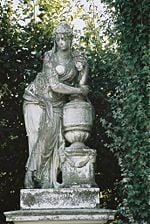
|
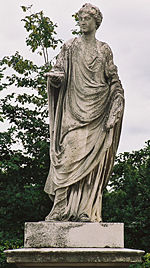
|
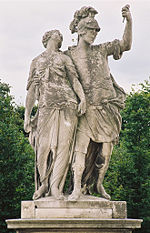
|
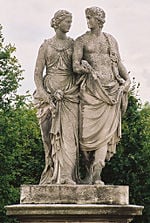
|
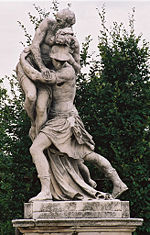
|
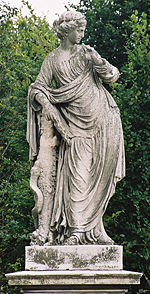
|
| 1 Artemisia II of Caria, wife of Mausolus | 2 Calliope, the muse of poetry | 3 Brutus and Lucretia | 4 Ceres the goddess of the agriculture | 5 Aeneas escapes from Troy | 6 Angerona |
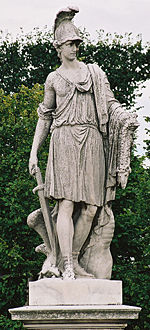
|
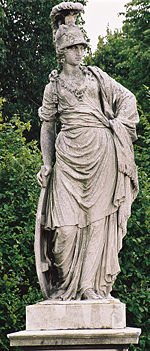
|
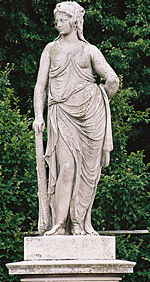
|
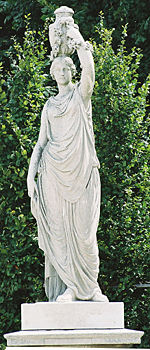
|
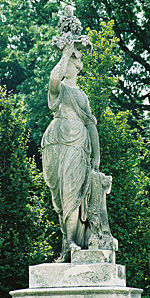
|
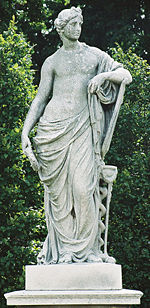
|
| 7 Jason, the Argonaut. | 8 Aspasia, second wife of Pericles | 9 Omphale | 10 The nymph Flora | 11 Bacchante | 12 Apollo |
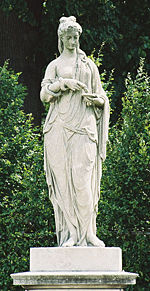
|
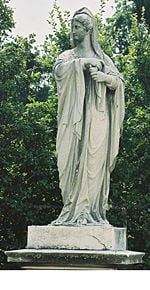
|
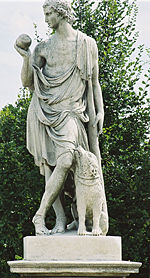
|
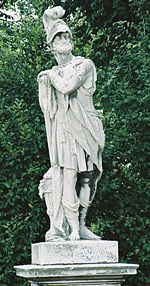
| ||
| 13 Hygieia godness of health. | 14 Vestal Virgin | 15 Paris | 16 Hannibal |
ReferencesISBN links support NWE through referral fees
- Glaser, Joseph. Schonbrunn Palace, The Administration of Schonbrunn Palace, 1962. ASIN B000S3984S
- Schmitt, Friedrich. Schonbrunn Palace: A Guide to the Palace and Park, Schlosshauptmannschaft Schonbrunn, 1979. ASIN B000K6XKE2
- Schonbrunn Palace. Schonbrunn, Verlag der osterbreichischen, 1978. ASIN B000REE6Z4
- Viault, Birdsall. Modern European History, McGraw-Hill, 1990. ISBN 978-0070674530
External links
- Official website
- photograph-gallery: Schönbrunn Palace
- Schönbrunn Palace: My Way of Telling History (.pdf format)
- Orangerie Schönbrunn
Credits
New World Encyclopedia writers and editors rewrote and completed the Wikipedia article in accordance with New World Encyclopedia standards. This article abides by terms of the Creative Commons CC-by-sa 3.0 License (CC-by-sa), which may be used and disseminated with proper attribution. Credit is due under the terms of this license that can reference both the New World Encyclopedia contributors and the selfless volunteer contributors of the Wikimedia Foundation. To cite this article click here for a list of acceptable citing formats.The history of earlier contributions by wikipedians is accessible to researchers here:
The history of this article since it was imported to New World Encyclopedia:
Note: Some restrictions may apply to use of individual images which are separately licensed.
